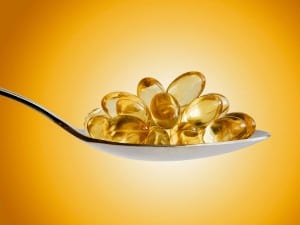Vitamin D is the general term given to the group of cholesterol-based hormones that maintain healthy calcium, magnesium and phosphate balance in blood and bone. Exalted as a wonder vitamin for the prevention and treatment of many diseases ((Michos, Erin, et al., Archives Internal Med, August 2008.)) , vitamin D is often recommended by both medical and naturopathic doctors in mega-dose supplements to correct low levels in the blood. The short-term benefits of this approach are unquestionable, however vitamin D supplementation, without reference to the bigger picture, can and often does result in serious degeneration and pre-mature death. ((Queen, HL (Sam)., Health Realities Journal. Vitamin D Health Panacea or Killer? Vol 21. No.1.pg.12,17.))
Vitamin D is essential for health and life. Synthesised as sunlight acts upon cholesterol in the skin, cholecalciferol (vitamin D3) progresses in the liver to calcidiol, which is the main storage form of vitamin D. Then, in kidney and bone, calcidiol develops into calcitriol, the active form that promotes calcium absorption and normal cell growth. Dietary animal fats also provide a significant source of D3 while certain plants synthesise to a form called ergocalciferol (vitamin D2). The most noted food sources include beef fat, calf liver, cod liver oil, salmon, eggs, butter, soft cheeses and full fat yoghurt.
Vitamin D supplementation, without reference to the bigger picture, can and often does result in serious degeneration and pre-mature death.
Vitamin D promotes optimal bone density and influences just about every cellular process in the body, including DNA replication. ((Whitfield, James F., “Calcium Cell Cycles, and Cancer”, CRC Press, Boca Raton, FL., 1990.)) The optimum serum reference range is 100-150 mmol/litre. A blood test result within this range is generally indicative of a balanced lifestyle and good health. Low levels do not, however, always indicate a need to supplement. As with a number of other essential nutrients such as iron and calcium, vitamin D can be over-supplemented, resulting in toxicosis, systemic calcification, arterial disease and even heart attack. ((Queen, HL (Sam)., Health Realities Journal. Vitamin D Health Panacea or Killer? Vol 21. No.1.pg.12,17.))
Vitamin D activates calcium-binding proteins that assist in calcium absorption and bone stasis, however, its role in maintaining calcium balance is secondary to the role of pH. When serum vitamin D levels are consistently sub-optimal, it is likely that destructive lifestyle habits are producing acid stress. An improper diet, lack of regular exercise, inadequate sleep, dehydration, overindulgence, emotional and spiritual stress, etc., will all tend to undermine the delicate acid/alkaline balance which is, in fact, the primary control for calcium balance.
Bone is constructed predominantly from protein, to which around 99% of body calcium is bound. One percent (1%) circulates in the bloodstream at an optimum concentration of 2.35-2.45 mmol/litre of blood. Over half of this 1% is bound to serum protein and various anions. The remainder, (i.e. approximately 0.45% of total body calcium) exists in a free form, ready to be absorbed by outer cell membrane for distribution to the inner cell. This function is so important for the control of systemic acidity that the body maintains a tightly controlled outside/inside balance of 10,000:1.
When lifestyle habits result in excessive acid stress and the pH of the blood consequently falls to a critical level, bone will disassemble, releasing phosphates and calcium into the bloodstream to stabilise pH.3 Bone protein and various anions are lost, advancing a state of osteoporosis, while freed calcium causes a cascade of further biological defects, including calcification and chronic inflammation. In this scenario vitamin D will be excreted and serum levels will plummet so as to inhibit additional calcium absorption. This emergency reaction will continue until excessive free calcium can be buffeted primarily with protein, and the pH corrected. ((Frassefto, L.A., Morris, RC Jr, Sellmeyer, DE, and Sebastian, A., “Adverse effects of Sodium Chloride on bone in the aging human population resulting from habitual consumption of typical American diets”. J Nutt 132(2) : 4195-4225. February 2008.)) , ((Wynn, E., et al., “Postgraduate Symposium : Positive influence of nutritional alkalinity on bone health”. Proc Nutr Soc 69(1) : 166-73, February 2010.))
A reliable marker for acid/alkaline status is  the chloride/phosphate ratio, which can be calculated from the electrolyte readings in a blood test.
the chloride/phosphate ratio, which can be calculated from the electrolyte readings in a blood test.
Chloride is the prime acid ion in the blood while phosphate is the dominant alkaline anion. A rise in the ratio above 30:1 is consistent with an increasing tendency toward acid stress, bone loss and calcium imbalance. A ratio of 25-27:1 is consistent with an alkaline tendency, healthy bone building and balanced calcium metabolism. If your result is above 30, you should review your lifestyle and areas of possible interference, including toxic dentistry. If your calculation exceeds 32 you need to consider a comprehensive detox and lifestyle program.
If the ratio is high it is likely that serum vitamin D has plummeted. In such a case, it would be detrimental to supplement with vitamin D. First correct the underlying issues by adjusting lifestyle habits and then get another blood test to reassess electrolytes and serum vitamin D. Does that make sense?
Some of the most extensive studies in relation to arterial and heart disease, cholesterol, dietary fat and vitamin D were conducted by Dr. Fred Kummerow (now age 97) during a 70+ year career in medical research. His team found that when marginally excessive amounts of vitamin D were supplemented, there was a subsequent initiation of arterial disease, followed by arterial calcification, irrespective of serum cholesterol or triglyceride levels. ((Taura. S., Taura. S., and Kummerow, et al., “Vitamin D induced coronary atherosclerosis in normolipemic swine : comparison with human disease”. Tohoku J exp Med 129(1) : 9-16 September 1979.)) Noting the important role played by magnesium in cholesterol metabolism, his team went on to study what happens when vitamin D is supplemented to pigs presenting a deficiency in magnesium. In all trials, the combination of low magnesium and excessive vitamin D did indeed promote the progression of arterial disease. ((Ito, m., Sekine, I., Kummerow, FA. “Dietary magnesium effect on swine coronary atherosclerosis induced hypervitaminosis D”., Acta Pathol Jpn 37(6):955-64, June 1987.)) It was further observed that the disease was most pronounced in subjects with the lowest protein status. Dr. Kummerow concluded that excess vitamin D encouraged absorption of more calcium at a time when calcium was already depositing in the arteries and elsewhere due to low protein and magnesium status. ((Toda, T., Ito, M., and Kummerow, FA. “Angiotoxicity in swine of a moderate excess of dietary vitamin D3. Food Chem Toxical 23(6) : 585-92, June 1985.)) , ((Toda, T., Toda, Y., and Kummerow, FA. “Coronary arterial lesions in piglets from sows fed moderate excesses of vitamin D” Tohoku J Exp Med 145(3) : 303.))
This may explain why so many studies of the elderly reveal low readings for vitamin D, and why supplementing vitamin D in old age heightens the risk of premature death. ((March 1985. 10. Holmes, R.P., and Kummerow, FA “The vitamin D status of elderly Americans”, AJCN 38(2) : 335-9, August 1983..)) As we age our demand for magnesium increases and our ability to digest and assimilate protein diminishes resulting in accelerated bone loss. Calcium supplementation is not the answer. As we progress past the age of 70, the body expresses a longevity (anti-aging) gene known as Klotho (KL). Klotho slows down bone loss by subduing parathyroid hormone and regulating phosphate/calcium metabolism. ((Kuro – OM., “Klotho as a regulator of fibroblast growth factor signaling and phosphate/calcium metabolism”., Curr Opin Nephrol Hypertens 15(4) : 437-41, July 2006.)) This action subsequently helps in the retention of magnesium, while conserving protein in the bones.
As the Klotho (KL) gene ultimately takes over the responsibility for regulating bone status, it becomes antagonistic to vitamin D. Accordingly, supplementing with vitamin D above 600 I.U.’s per day when over age 70 carries some very serious risk. Excessive vitamin D will suppress the expression of the powerful anti-aging Klotho gene, resulting in premature decline. Those with low to normal levels of serum vitamin D in old age tend to live longer. ((Queen, HL (Sam)., Health Realities Journal. Vitamin D Health Panacea or Killer? Vol 21. No.1.pg.12,17.)) , ((Rozzaque, M.S., and Lanske, B., “Hypervitaminosis D and premature aging : Lessons learned from Fgf23 and Klotho mutant mice”, Trends Mol Med 12(7) : 298-305 July 2006.))
“In case of sickness, the cause should be ascertained. Unhealthful conditions should be changed, wrong habits corrected. Then nature is to be assisted in her effort to expel impurities and to re-establish right conditions in the system”. ((Health and Happiness. EG White; pg 76. 1905. Inspiration Books East Inc.))
The body is made by design to win. Sub-optimal readings in a blood test do not necessarily indicate deficiencies or excesses, but may in fact, reflect the body’s effort to protect itself. We are all programmed with a homeostatic tendency to survive, and the body will execute winning strategies in every situation. If your blood test reveals a low serum vitamin D, you may just need more sunlight, animal fats and/or cod liver oil. If you are young to middle aged it may even be beneficial to supplement, but only ever up to a maximum dose of 2000 IU’s per day. Optimal serum levels (i.e. 100-150) are associated with a reduction in cancer risk, heart disease, diabetes and many other degenerative diseases, but these levels can only be reached safely through the regular practice of healthy lifestyle habits. If your chemistries reveal a tendency toward acid stress along with a subsequent low serum vitamin D, there is work for you to do.
Get specific solutions for your health with a retreat program at Living Valley. Find out more by visiting our retreat overview page or calling 1800 644 733.









